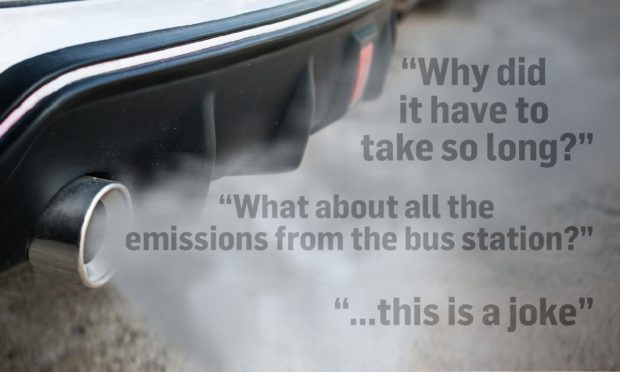Aberdeen’s low emission zone (LEZ) is set to cover the majority of the city centre when it is introduced next spring, but there are still a number of unanswered questions surrounding its creation.
What about the harbour and bus station? Why is a brand new diesel not allowed when its exhaust emissions are so low? Why isn’t Wellington Road included in the proposed zone?
We took these and some of the other commonly asked questions from readers and put them to two experts to get some answers.
Meet the Experts
Professor Sean Semple is an air quality specialist who spent 20 years working at the University of Aberdeen, with a particular focus on researching the health effects of air pollution. He now works at the University of Stirling but has a keen interest in Aberdeen’s new LEZ.
Gavin Thomson is an air pollution campaigner for Friends of the Earth Scotland. He has worked in the industry for several years and has particular knowledge on the links between transport, urban planning and health.
Question One: What about the bus station, train station and harbour?

Gavin Thomson: “We tend to think that the bigger modes of transport like ships, ferries and trains must be more polluting because they are older vehicles oftentimes. But that comparison isn’t helpful.
“What we need to be concerned about is the damage that air pollution does to people and what happens when we breathe it in. That’s why roadside pollution – pollution from cars – is so alarming and what we need to focus on. Because that’s where people are, they are at the side of the road, they are walking along the streets, going to school going to work.
“Some of the freight and ships for example in Aberdeen harbour might be really polluting, but by the time that is dispersed and reaches where people are, it doesn’t make that much of an impact compared to car traffic in the city centre. That is what modelling for the LEZ has shown. It’s not nearly as much of a concern as car traffic.
“The Scottish Government also have some pretty ambitious targets for decarbonising the rail network (more than 75% of journeys in Scotland are already on electric trains) and also Scotland’s bus fleet which is great. The SNP manifesto commitment for the majority of buses in Scotland to not run on fossil fuels by 2023 is really ambitions. Aberdeen is going to start seeing a lot more electric buses in addition to the hydrogen ones currently running.”
Question two: Why is my new diesel not allowed when it produces low emissions?

Gavin: “Diesel pollution gives off nitrogen dioxide, that’s the pollutant that the UK has a real problem with, not just the health impacts but legally we’ve been way above the legal limit for a really long time.
“That only comes from diesel vehicles, not from petrol. So in many ways, it’s the diesel-heavy, and particularly the older diesel vehicles that are on our roads, that have prompted the need for these low emission zones in the first place.
“In the late 90s, the versions of diesel and petrol that were around then were different than they are now. Diesel was slightly better for greenhouse gas emissions per mile and so Gordon Brown incentivised diesel.
“It was made a little bit cheaper, various public bodies were encouraged to buy diesel vehicles in procurement, all that kind of thing. So consumers and car buyers were definitely encouraged into buying diesel by the government, it was a government mistake ultimately.
“But that led to a diesel heavy fleet on our roads which is polluting our air and breaking the law. And we need to take action.”
Question three: Why is the LEZ happening now?

Gavin: “The LEZ in Aberdeen city centre was supposed to be in place in 2020, but it’s been delayed due to Covid-19 among other reasons.
“Now it will be live technically from mid-2022, but it won’t restrict any vehicles until 2024.
“So if you think about that for a moment, Scotland has been breaching legal limits for diesel pollution since 2010 and no real action will have been taken in Aberdeen until 2024. That’s 14 years.
“So if you were born in 2010 and particularly if you live near a main road, you are at huge risk while you’re growing up of your lungs not developing properly because of breathing in traffic fumes. And you’ll be 14 by the time any meaningful action has been taken.”
Question four: Aberdeen’s most polluted roads are actually outside the proposed low emission zone. Is that relevant?

Sean Semple: “One of the recognised issues with low emission zones is that they can increase traffic in areas around the periphery of the restrictions.
“I think it will be really important to make sure there is adequate investment in good public transport links and active transport to encourage walking and cycling, and provide people with realistic alternatives to car travel if a low emission zone is implemented.”
Gavin: “Some of the hot spots aren’t in the proposed zone (and this isn’t just the case for Aberdeen, but also Glasgow, Edinburgh and Dundee too) which is a real cause for concern.
“But what the councils say is that if we change the way people travel in the city and the way journeys are made, then it will mean an air quality improvement on all the roads across the city.
“But of course this won’t work in isolation. There needs to be improvements to pavements, a joined up network of cycle lanes and improvements to public transport.”
Question five: Does air pollution really harm my health?

Sean: “There is increasing evidence that air pollution impacts on our health. We have known since the 1950s that periods of poor outdoor air quality increase mortality, the number of deaths immediately after the days when pollutant levels are high.
“Since then many studies have shown associations between ‘bad air’ days and a whole range of health outcomes. These are not just respiratory or breathing problems but we also know that pollution impacts on cardiovascular health: heart attacks and strokes also increase when air pollution is high.
“More recently there have been studies suggesting that pollution may be linked to reduced immunity: with studies showing that cells in our lungs that are exposed to fine particles from traffic may be more susceptible to bacterial infection.
“Other studies have indicated an association between air pollution and cognitive effects and dementia.”


